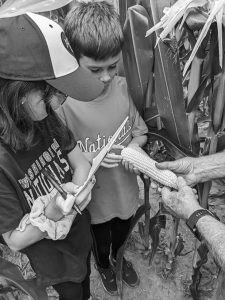Kids and corn
Published on September 1, 2023 at 12:31pm CDT
View From The Cab
By David Tollefson, Columnist

 The week of Aug-21-25 I had the rare privilege of hosting my son, wife and two kids at the farm. They presently live in Frankfurt, Germany, and as of last Monday they are back home.
The week of Aug-21-25 I had the rare privilege of hosting my son, wife and two kids at the farm. They presently live in Frankfurt, Germany, and as of last Monday they are back home.
At this time of the year, I go into my corn fields and take some samples of cobs of corn, get some population counts, kernel counts, and put the figures into my laptop computer and calculate out the potential yields that the fields may produce.
I told Satri (10) and Soren (8) that they and their dad could come along into the corn field near my place and see what we could find. Satri was the “recording secretary,” writing in a notebook the population (this is from 17.5 feet of a 30- inch row), figuring 1 1/000 of an acre.
First, we measured the height of the corn (9 feet), then we strung out a 25-foot tape measure to 17.5 feet, and Satri recorded 32 stalks. Then we went down the row in that 17.5 feet, snapped off the third ear, the fifth ear and the seventh ear. Those are the cobs that you see in the picture. A couple of the cobs have “tip-back” (kernels not filled to the end of the cob). This is all on a clay hill along my driveway.
On those three ears, we counted the rows around (16, 18, 18) for an average of 17.3 rows per cob. Then we counted the length of the three cobs in kernels long (36, 34 and 31) for an average of 33.6.
When those figures are put into my laptop computer, (I have several years of data to compare with), this sample of three ears had a potential yield of 219 bushels an acre.
Bear in mind that this is a very, very small sample of the 15-acre field. And, as indicated above, it’s on a clay hill. The particular field has all types of soil, from heavy black gumbo to sandy spots, to rocky spots.
After the family left, I took the time to sample a couple other areas of the same field, one a black loam area, and the other a lower area that is not black but has washed-in dirt from the hill above it. Those samples, with the same criteria, measured 240 bushels an acre and 261 bushels an acre.
Here’s where the variability factor comes in. Kernel counts do not account for depth of kernels, test weight and so on. But the kernels on these cobs are fully dented, the corn stalks are quite fully green, the husks have not dried up and the cobs are pretty much sticking straight up.
In our area, I see corn that obviously was planted way before mine, where the husks are beginning to dry up and the cobs drop down.
But remember, we are in quite a drought here. We corn farmers are amazed that the corn and beans are as good they seem to be. My last meaningful rain was Sunday, Aug. 13 when most of the area got over 2 inches of slow, gentle rain.
But walking in most corn fields around here can be a challenge. There are leaning stalks from the tremendous wind storm of July 25. Harvest of most fields is going to be not much fun. Some fields may have to be harvested one way to get as much as possible.
In looking at rainfall during the growing season this year compared to last, a year ago in May we had 7.8 inches, compared to 1.2 inches in May of 2023.
Comparing the two years’ growing season rainfall, in 2022 we had 16.15 inches through August. This year almost 5 inches less, 11.84 inches April-August.
The long-term forecast into September is not favorable for more rain, either. But maybe the current hurricane bringing tragic amounts of wind and rain to Florida will trigger some rain here.
So, our bean and corn crops will more than likely have to mature with the subsoil moisture that we have. Every day without rain, and with the expected 90s, reduces test weight and yield of corn, and same with soybeans.
I see some harvest of edible beans in the neighborhood. I would imagine that the size of those beans too might be impacted by the drought.
In closing, I did spend part of the day Saturday, the 26th at the state fair. It was an absolutely perfect day, temperature-wise. But it was an all-time record number of attendees for day two of the fair – 164,000 or so.
After staying at our daughter and son-in-law’s house near Stillwater, I drove in myself to a church parking lot near south Snelling Avenue. From there I rode the half-hour bus ride to the fair. What a perfect way to handle the traffic issues.
I had hoped to have breakfast at the fair, like at a church stand that served pancakes, but was not going to stand in line for a half-hour. But I did find a stand inside a building called the Garden, where they offered a delicious breakfast burrito, and the coffee was free. All for $8! The bargain of the fair!
For a time, I met the family from Germany, as well as the Stillwater folks at the fair. What a challenge to stay together (seven people). Thank goodness for cell phones to get together again!
* * * * * * * * * * * * *
Please contact David Tollefson with thoughts or comments on this or future columns at: adtollef@hcinet.net




